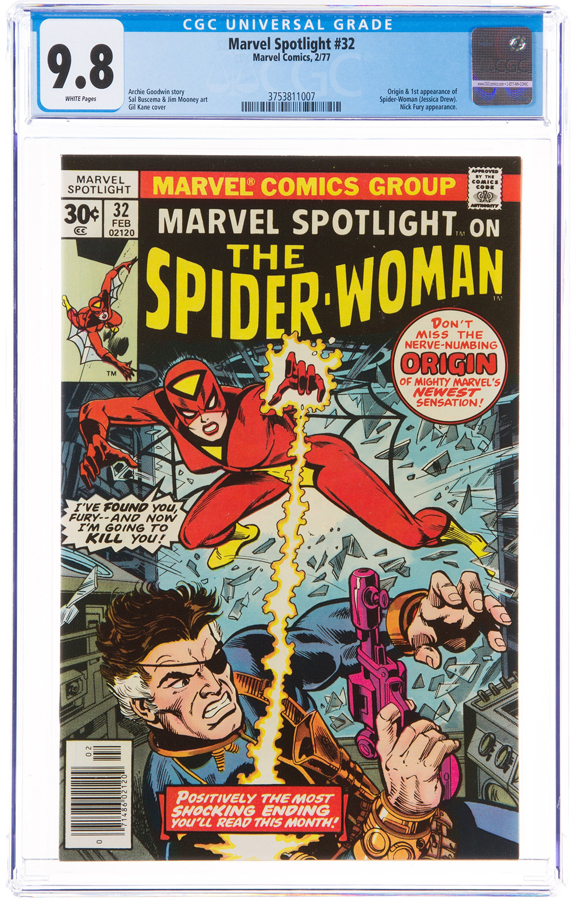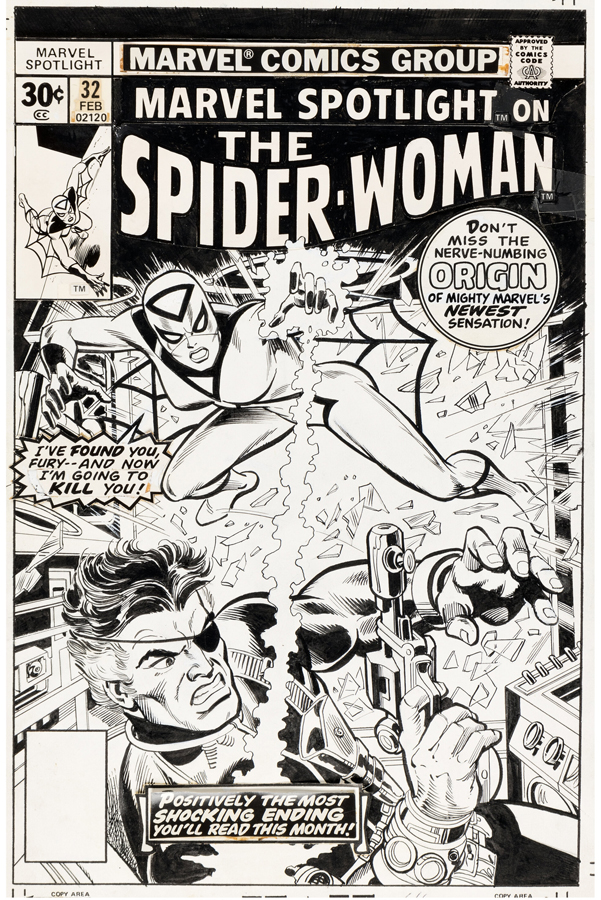HOW THE ONE-OFF MARVEL CHARACTER WENT FROM 1970S COPYRIGHT HOLDER TO 21ST-CENTURY SPIDER-VERSE SUPERHEROINE
By Robert Wilonsky
In March 1978, Stan Lee flew to Harrisonburg, Virginia, as the guest of honor at James Madison University’s Fine Arts Festival. As The Comics Journal would later point out, it wasn’t the likeliest of destinations for the man at the helm of Marvel Comics, in large part because James Madison’s a small, remote campus without “that air of student bohemia that one would normally associate with a school Stan the Man would be likely to visit.” Also, there wasn’t a comic shop near campus – or, really, anywhere nearby. As a result, the turnout was slim as Lee took the small theater’s stage joined by four interviewers.
Perhaps because Lee was speaking that day to an intimate group of True Believers, he was especially forthright about several topics – among them, the origin story of a relatively new character called Spider-Woman, who was created by Archie Goodwin and Marie Severin (who designed her costume) and made her debut in Marvel Spotlight No. 32. Throughout much of the book, which hit newsstands in November 1976, “The Spider-Woman” is referred to as Arachne, a name lifted from Greek mythology. Hers was a complicated origin story involving HYDRA, the scientist called High Evolutionary and a plot to kill Nick Fury. But long story short, she was said to be “descended from a totally different species” – a spider, natch.
‘Marvel Spotlight’ No. 32, featuring the first appearance of Spider-Woman
Panelist Pierce Askegren, described by The Comics Journal as a “comic collector and aspiring writer,” asked Lee, “What type of thinking went into that character? Was it just a name that popped up?”
Lee paused for a second, then explained that, look, not a whole lot of thought went into Spider-Woman – who, in time, became enough to star in her own book and a 16-episode cartoon; was killed off after 50 issues; came back to life as a member of the New Avengers and became a major player in the Spider-Verse and Secret Wars.
“You know why we did it, really?” Lee said. “I suddenly realized that some other company may quickly put out a book like that and claim they have the right to use the name, and I thought we’d better do it real fast to copyright the name. So we just batted one out quickly, and that’s exactly what happened. I wanted to protect the name because it’s the type of thing someone else might say, ‘Hey, why don’t we put out a Spider-Woman? They can’t stop us.’”
Writer Marv Wolfman, who would later take over writing Spider-Woman, thought it was a joke when he first heard it discussed in the office.
“Running through my mind was – what’s next?” Wolfman wrote in “Confessions of a Comic Book Writer,” which filled a full page at the end of Spider-Woman No. 1, published three days into 1978. “THE LEAGUE OF SPIDEY PETS? How about SPIDER-MAN’S PAL, HARRY OSBORNE? This couldn’t be happening. This is Marvel! We may be maniacal. But we’re not mad.”
However, as Screen Rant’s Thomas Bacon noted in 2020, Lee “had never forgotten legal wrangling with DC over Marvel’s Wonder Man, or the frustration he’d felt when DC created Power Girl. Spider-Man was Marvel’s biggest brand, and it made sense for Marvel to protect it by creating their own Spider-Woman.”
Wolfman thought it was all “one big joke” and “a stupid idea.”
Then he saw the finished product, which was illustrated by Sal Buscema and written by the great Archie Goodwin, who’d written for Creepy and other Warren titles before jumping to Marvel in 1968, where he served as editor-in-chief during Spider-Woman’s creation.
Gil Kane’s cover art for ‘Marvel Spotlight’ No. 32 is available in Heritage’s April 3-6 Comics & Comic Art Signature® Auction.
The cover by Gil Kane, perhaps best known for having designed the Silver Age Green Lantern’s costume during his acclaimed tenure at DC Comics, completed the holy trinity. In fact, years later, Kane’s introduction of The Spider-Woman was among the 41-cent stamps issued in 2007 by the United States Postal Service to celebrate Marvel Comics, alongside covers from the first issues of The Amazing Spider-Man, The Incredible Hulk, The X-Men, The Invincible Iron Man and Sub-Mariner – easily identifiable icons all.
It took just three decades for the character to leap from the drawing table and the spinner rack to the Smithsonian’s National Postal Museum – and now, finally, to auction as one of the centerpiece offerings in Heritage’s April 3-6 Comics & Comic Art Signature® Auction.
“Well, it was good,” Wolfman wrote. “No, strike that – it was great! I really loved it. It wasn’t Spider-Man, it wasn’t even a distant relation. In fact, I was told that Stan didn’t want Spider and Webby (which is what I call our alluring arachnid) to even meet for a long, long time. Spider-Woman was her own character, and a totally interesting one.”
So much so that Wolfman asked to include her in Marvel Two-In-One, pairing her with The Thing for Issue No. 30 while updating her origin story to something slightly less … outlandish, let’s say. He gave her a secret identity: Jessica Drew, her first name shared with Wolfman’s newborn daughter. And he outlined a future for the character that saw her as something less – and more – than “a strict super-heroine.” Wrote Wolfman of Spider-Woman, who would become a bounty hunter and a private detective, “She will primarily be a crime-fighter, a stalker of evil, a dark nemesis of the underworld. She is grim and determined, and possesses a strange sort of – dare I say it at the risk of sounding corny? – innocence.”
Spider-Woman debuted in 1977 without knowing her name, her origin, her anything, really. She was a great costume and a great cover in search of a great story.
Now, all these years later, Spider-Woman has become as much a fixture in the Spider-Verse as the Spider-Man to whom she bore no relation. She might have started as a copyright placeholder, but to a new generation, she’s a prominent – and pregnant – member of the cinematic Spider-Society voiced in Spider-Man: Across the Spider-Verse by Insecure creator, writer and star Issa Rae.
Spider-Woman is “just so brave and confident in a way that I am not,” Rae told USA Today in May 2023. “She’s also doing all of this while with child, and that was really compelling to me and confusing and kind of scary to portray. … To play [Jessica] opened my eyes to the pregnant women around me who are working and kicking ass, in metaphorical and physical ways.”
You might even say that with great power comes … well, you know.
 ROBERT WILONSKY is a contributor at Intelligent Collector.
ROBERT WILONSKY is a contributor at Intelligent Collector.



